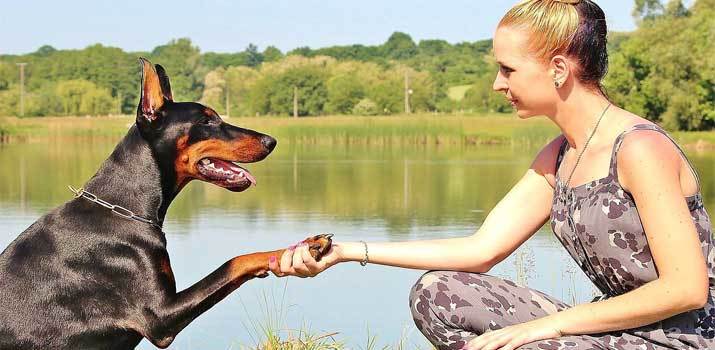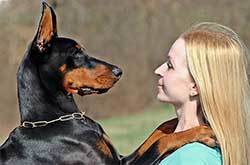
Have you ever been sitting and minding your own business only to feel that warm and furry touch of a dog paw on your leg? Join the club!
This behavior is very common for canines. They're not able to communicate through words as we do. So, your furry friend has to develop different ways to say what they want.
Touch is the easiest way for dogs to grab your attention. It's no coincidence, either!
Think about the way you communicate with your dog beyond words. Chances are, you use your hands to pet them.
Even if you're scolding your dog for bad behavior, you might point your finger at them or wave your arms as a way to get them to stop doing something.
Canines are cunning creatures. They pick up on those hand gestures and try to use them to their advantage. But what exactly are they trying to say? Here are some of the most common reasons why dogs put their paws on you.
8 Reasons Why Dogs Put Their Paws on You
1. They Are Seeking Attention
If you spend all day working at your desk, don't be surprised if your pup puts their paws on you. It's their way of saying they need some attention!
Think of it as a gentle reminder that your dog is still there and has some social needs you need to fulfill!
Many dogs will do this if you ignore them for several hours. You may even witness it after your pup has taken a hearty nap. Read your dog's other body signs.
If the ears are pricked up while the mouth is relaxed, they simply want you to focus on them for a minute. You might also see a wagging tail and an attentive gaze! Give your pup some loving!
2. They Want to Go Outside
As dogs get older, they will get a bit more independent about going outside to do their business. They stop relying on frequent potty breaks and learn how to notify you of when nature calls!
In most cases, the pawing will be accompanied by tapping toes and a wagging tail. You might even see them turning their head towards the door.
It's your companion's way of letting you know that they need to go!
3. They Want to Play
When your dog starts pawing at your leg, take a look at the floor around them. Did they bring a toy with them? If so, they're simply asking you to play!
You might see some excited tapping or jumping, too. Your pooch is bored and wants you to play with them.
Whether or not you grant that wish is up to you. But if you've ignored them for most of the day, it may be beneficial to spend a few minutes burning that energy off.
4. They Are Hungry
It's interesting how dogs develop an internal clock about dinner time.
Only give in to this pawing if it's truly dinner time for your dog! Providing food outside of feeding hours will only create a bad habit.
Your dog will resort to begging because they think that they can get food whenever they want. That's a big no-no.
Also, you need to ignore your dog if they are pawing at you when you're eating something. Never reward begging!
5. They Are Feeling Anxious or Insecure
Sometimes, dogs just need a bit of comfort. In the eyes of your dog, you're the one and only source of it. So, they'll turn to you whenever they are feeling anxious or insecure.
Maybe your dog is in a new environment that has them feeling scared. Or, they could be feeling down after you scolded them.
Whatever the case may be, the pawing is a sign that your dog is experiencing some mental anguish. You can identify this with flat ears, yawning, or lip-smacking.
As tempting as it is to console your pet every time they need it, you have to exercise some restraint. If you console your pet all the time, you're only justifying those feelings.
This could lead to more anxiety in the future. There's a fine line between rewarding anxious behavior and teaching your dog that there's nothing to be down about.
6. They're Directing Your Pets
If your dog starts pawing at you when you're petting them, they could be trying to direct you to the "sweet spot!" Don't take it as your dog trying to command you.
As long as they aren't barking or showing signs of aggression, the pawing is merely a suggestion.
They love your pets so much that they want you to pet elsewhere!
7. They Are in Pain
Physical pain could cause your dog to paw at you, too. Your pup can't tell you what's wrong. They might not even know themselves! So, their only option is to get your attention in hopes that you make it go away.
Look out for other signs of physical pain. You might be able to spot the problem right away. For example, they could have hurt their leg , a cracked paw or gotten into some thorns.
If the pawing persists, go to the vet. Your vet can give your pup a full examination to rule out any potential medical issues.
8. They Just Love You

Finally, your dog could be pawing at you just to say that they love you. This is, by far, the most heart-melting reason! Dogs love pets.
When you pet them, your dog is experiencing a rush of hormones that make them feel great.
Your pup may try to return the favor by petting you, too. This behavior could be accompanied by head nudges, snout pushes, and all kinds of physical touches.
We could all use a bit of love in our lives, so why not return the favor?
What If I Want My Dog to Stop?
There's no shame in wanting your dog to stop placing their paws on you. Paws can be filthy!
The trick to stopping it is to ignore it.
If you don't acknowledge the behavior, your dog will eventually learn that pawing will get them nowhere. Be consistent.
Don't confuse your dog by acknowledging their paw sometimes but ignoring it the next.
Conclusion
When your dog puts their paw on you, it's their way of communicating. To understand what they're trying to say, you have to rely on other forms of body language.
In most cases, the behavior is nothing more than a sign of affection. It's a way for your dog to bond with you. As long as it doesn't lead to negative behaviors, don't be afraid to acknowledge it.
Also read:

